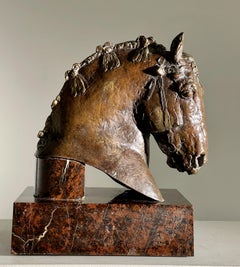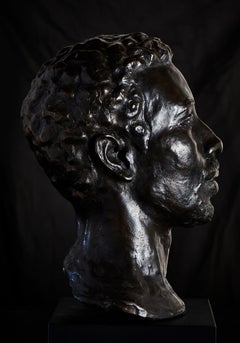Thomas PROCHNOW Sculptures
to
1
Overall Width
to
Overall Height
to
1
1
1
1
1
1
215
183
166
136
1
Artist: Thomas PROCHNOW
Dogs of War, 2003
By Thomas PROCHNOW
Located in Atlanta, GA
Thomas Prochnow is a German Postwar & Contemporary artist who was born in 1978. Their work was featured in several exhibitions at key galleries and museums, including the Semjon Con...
Category
21st Century and Contemporary Realist Thomas PROCHNOW Sculptures
Materials
Mixed Media
Related Items
"Sudbourne Premier: Suffolk Punch Stallion" Herbert Haseltine, 1927 Bronze
Located in New York, NY
Herbert Haseltine
Sudbourne Premier: Suffolk Punch Stallion, 1927
Signed left side: © HASELTINE / MCMXXVII
Bronze, dark brown patina, parcel gilding
...
Category
1920s Realist Thomas PROCHNOW Sculptures
Materials
Bronze
$35,000
H 10.5 in W 11.5 in D 6.5 in
Life Size Sculpture of Male Head in Patina Bronze "Diadji"
By William J Rushton
Located in New York, NY
Bronze life-size male head with a dark brown patina. Sculpted in Florence Italy and casted in bronze just outside of the city. This is an earlier piece that holds a distinctly differ...
Category
2010s Realist Thomas PROCHNOW Sculptures
Materials
Bronze
$6,000
H 15 in W 8.5 in D 9 in
Seahorse -original figurative bronze marine sculpture-artwork-contemporary Art
By Andrzej Szymczyk
Located in London, Chelsea
This exceptional artwork is currently on display and available for sale at Signet Contemporary Art Gallery and online.
"Hippocampus" by Andrzej Szymczyk is a captivating bronze scul...
Category
21st Century and Contemporary Realist Thomas PROCHNOW Sculptures
Materials
Bronze
Andrzej SzymczykSeahorse -original figurative bronze marine sculpture-artwork-contemporary Art, 2025
$5,517
H 13.39 in W 4.34 in D 3.55 in
"Cowrie Shell" (2024) By Tony Hochstetler, Original Bronze Sculpture
Located in Denver, CO
Tony Hochstetler's "Cowrie Shell" (2015) is an original handmade bronze sculpture that depicts the shell of a cowrie.
TONY HOCHSTETLER is a sculptor of unusual animals and botanical...
Category
2010s Realist Thomas PROCHNOW Sculptures
Materials
Bronze
$450
H 1.75 in W 3.5 in D 2.25 in
Debora Lima-original figurative female dancers bronze sculpture-contemporary Art
By Andrzej Szymczyk
Located in London, Chelsea
This exceptional artwork is currently on display and available for sale at Signet Contemporary Art Gallery and online.
Bronze , Limited edition of 8
"Debora Lima" stands as a capti...
Category
21st Century and Contemporary Realist Thomas PROCHNOW Sculptures
Materials
Bronze
$8,276
H 25.2 in W 7.88 in D 7.49 in
"Poodles: Nora and Sheila" Herbert Haseltine, Bronze Dogs Animals Sculpture
Located in New York, NY
Herbert Haseltine
Poodles: Nora and Sheila, 1944, cast 1945
Signed and dated on base
Bronze with green patina
11 inches high x 17 inches wide x 6 inc...
Category
1940s Realist Thomas PROCHNOW Sculptures
Materials
Bronze
$28,000
H 11 in W 17 in D 6 in
Life Size Sculpture of Female Head in White Terracotta Clay "Yasmina"
By William J Rushton
Located in New York, NY
Gypsum-based white terracotta life-size female head. Sculpted and kiln fired in Florence Italy, this work is now kept in Rushton's studio in central Manhattan.
Rushton sculpts all ...
Category
2010s Realist Thomas PROCHNOW Sculptures
Materials
Terracotta
$8,000
H 15 in W 14 in D 14 in
Life Size Sculpture of Male Head in Terracotta Clay "Giorgi"
By William J Rushton
Located in New York, NY
Terracotta life-size male head.
Rushton sculpts all of his busts using live models over the course of multiple sittings. While realistic and classical in character, his sculptures ...
Category
2010s Realist Thomas PROCHNOW Sculptures
Materials
Terracotta
$4,500
H 12 in W 10 in D 10 in
Pole Dancer-original nude figurative bronze sculpture-artwork-contemporary Art
By Andrzej Szymczyk
Located in London, Chelsea
This exceptional artwork is currently on display and available for sale at Signet Contemporary Art Gallery and online.
Andrzej Szymczyk's "Pole Dancer" stands as a mesmerizing testa...
Category
21st Century and Contemporary Realist Thomas PROCHNOW Sculptures
Materials
Bronze
Andrzej SzymczykPole Dancer-original nude figurative bronze sculpture-artwork-contemporary Art, 2025
$7,172
H 19.69 in W 14.18 in D 7.88 in
Life Size Sculpture of Male Head in Terracotta Clay "Andrea"
By William J Rushton
Located in New York, NY
Terracotta life-size male head.
Rushton sculpts all of his busts using live models over the course of multiple sittings. While realistic and classical in character, his sculptures ...
Category
2010s Realist Thomas PROCHNOW Sculptures
Materials
Clay, Terracotta
$8,000
H 2.5 in W 14 in D 11 in
Life Size Sculpture of Male Head in Patina Bronze "Giorgi"
By William J Rushton
Located in New York, NY
Bronze life-size male head with a dark brown patina.
Rushton sculpts all of his busts using live models over the course of multiple sittings. While realistic and classical in charac...
Category
2010s Realist Thomas PROCHNOW Sculptures
Materials
Bronze
$6,500
H 11 in W 9 in D 9 in
Fifth Position Maquette (resin sculpture)
By Carole Feuerman
Located in Aventura, FL
Original one of a kind resin sculpture. Initialed and dated "CJF 85" by Carole A Feuerman.
Artwork in Excellent Condition. Please do not hesitate to ask us any further questions. ...
Category
1980s Realist Thomas PROCHNOW Sculptures
Materials
Resin
Thomas Prochnow sculptures for sale on 1stDibs.
Find a wide variety of authentic Thomas PROCHNOW sculptures available for sale on 1stDibs. You can also browse by medium to find art by Thomas PROCHNOW in mixed media and more. Not every interior allows for large Thomas PROCHNOW sculptures, so small editions measuring 95 inches across are available. Thomas PROCHNOW sculptures prices can differ depending upon medium, time period and other attributes. On 1stDibs, the price for these items starts at $45,500 and tops out at $45,500, while the average work can sell for $45,500.


